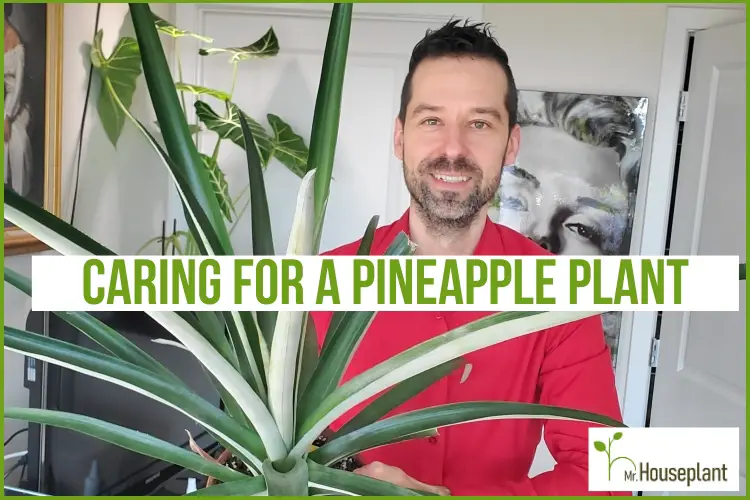
Do you find the idea of an indoor Pineapple plant super appealing, but you don’t know where to start from? What type of soil to use, should you fertilize it, can you make it flower? If you’re looking for answers to these questions, then read on.
| Botanical Name (Latin Name/Scientific Name): | Ananas Comosus |
| Common Name: | Pineapple |
| Light: | full sun (10,000 lux – 40,000+ lux) |
| Watering: | when the soil dries out to the bottom of the pot |
| Soil: | well-draining mix |
| Repotting: | Once a year |
| Temperature: | 65°F to 75°F (18°C to 24°C) |
| Humidity: | 25% to 50%, but adapts well to any humidity |
| Toxicity for Pets: | Non-toxic |
| Toxicity for Humans: | Yes (a skin rash or irritation) |
| Propagation: |
|
| Pruning: | Prune dead or diseased growth or when you want the plant to branch out |
Light Requirements
| Minimal amount of light: | 10,000 lux (1,000 FC) |
| Optimal amount of light: | 40,000+ lux (4,000+ FC) |
| Direct sun tolerance: | 8 hours |
| Category: | full sun |
Pineapple plant light requirements are high since it is a full sun plant. Ideally, they should get 7-8 hours of direct sunlight per day. This doesn’t mean they can’t grow with less light, but it will take longer.
They can grow in bright indirect light (over 3,000 lux/ 300 FC). However, don’t expect them to look great. They will grow extremely slowly, unlikely to produce fruit and the leaves will be spindly.
On the other hand, pineapple plants can grow rather fast if you provide them with enough light. My pineapple plants get 3-5 hours of direct sunlight per day (40,000-100,000 lux/ 4,000- 10,000 FC). And around 5,000-10,000 lux ( 500- 1000 FC) of indirect light.⠀
Thus, the basic light requirements should start at least at 10,000-15,000 lux (1,000- 1,500 FC). If you can’t provide this much light, you can use grow lights.
Water Needs
You should water your pineapple plant when the soil dries out completely. Pineapple plants tolerate dry soil very well. You can easily check if the soil is dry by inserting a chopstick until you’ve reached the bottom. If the chopstick comes out dry, it’s time for watering pineapple plants.
When it comes to my pineapple plants, I always wait until the soil is fully dry until the bottom of a pot.
You can also water your Pineapple Plant when the top few inches of soil are dry. However, this primarily depends on the amount of light your plant gets. If it gets a lot of direct sunlight and a proper potting mix, you don’t have to wait for the soil to fully dry out.
Humidity Needs
A Pineapple Plant has average humidity needs, between 25% to 50%. Still, like all houseplants, it adapts well to even lower humidity. And since most plants love high humidity, a Pineapple plant wouldn’t mind humidity over 50%.
Temperature Requirements
Ananas Comosus requires temperatures between 65°F/18°C at and 75°F /24°C. Coming from subtropical regions, the Pineapple doesn’t tolerate frost or very low temperatures.
Fertilizing
The best Pineapple fertilizer is fresh soil. In other words, if you repot your pineapple plant once a year you don’t need to fertilize it. The main reason for this is that the fresh soil will provide new nutrients.
This doesn’t mean you can’t fertilize. Since pineapple plants require a lot of light, it means they will photosynthesize more. This means faster growth and the need for more nutrients. If you want to fertilize, I would suggest the Sill fertilizer because it has an N-P-K ratio of 9-3-6 which is excellent for most plants.
If you decide to use fertilizers always follow the instructions and measurements on the package because too much fertilizer can seriously damage or even kill your pineapple plant.
What you should also keep in mind is that you should never fertilize your plant in its dormant phase. In this phase, the nutrients from fertilizers would accumulate in the soil since the plant isn’t using them. This will cause damage and burn the roots.
Soil
The best way to choose the right soil for Ananas Comosus is to use well-draining soil, like MotherEarth GroundSwell. This mix can be used straight out of the bag, whereas most other potting mixes need to be amended first.
I prefer to make my own potting soil mix and I use 2 parts all-purpose soil, 1 part perlite, 1 part bark, or some other amendment like pumice, sand, etc.
The main reason why I like making my own mix is because most commercial mixes contain peat moss or coco coir. They contain tiny particles which don’t leave a lot of space for oxygen. Without sufficient oxygen in the potting mix, it’s easier to develop bacteria and fungi that will cause root rot.
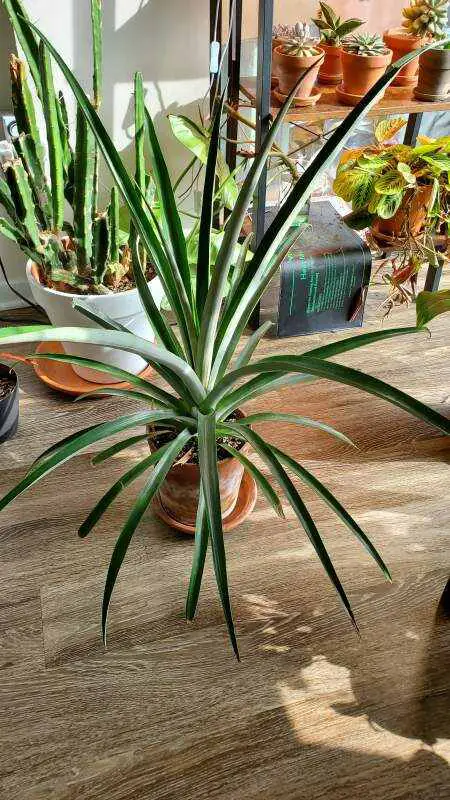
My reported Pineapple Plant
However, if you add an amendment with larger particles, such as perlite or bark, the chance of root rot is reduced as a result of macro pore creation that contain oxygen.
Repotting
When the time comes for your Ananas Comosus plant to be repotted, you need to take care of two things:
- Not to cut yourself on its sharp leaves and
- Not to stress your plant too much
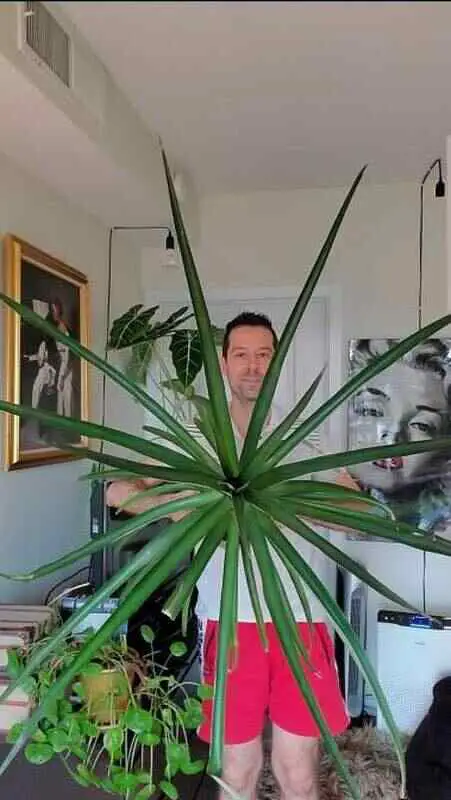
My beautiful, big Pineapple Plant
As the plant gets bigger, the leaf edges become serrated, and you can end up with some serious cuts.
Moreover, the leaf tips can easily poke your eye out if you’re not careful. Hence, I always put glasses on when I’m watering my pineapple and quite often, I wear gloves, too.
This is how I protect myself when repotting my Pineapple Plant:
I usually remove roots at the bottom since they get so stuck together that they block the flow of water and nutrients. If I want to keep the plant in the same pot, I prune some roots.
Removing the soil and part of the roots can be very stressful for the plants because you are also removing the sugar stored in those roots. For plants, it means you are depriving them of their food reserves. This could temporarily stress the plant and slow down it’s growth.
On the other hand, if you don’t want to stress your plant too much, you can just loosen the rootball without any root pruning and repot into a pot 2”-4” bigger.
If you want to see how I repotted my Pineapple Plant, check the video below
Toxicity To Humans
Pineapple Plant is toxic to humans and can cause a skin rash or irritation according to Ann King Filmer, Ph.D. Plant Scientist from the University of California, in the publication “Safe and Poisonous Garden Plants” from October 2012.
Toxicity To Pets
A Pineapple plant is not toxic to pets according to the American Society For The Prevention Of Cruelty To Animals (ASPCA). However, the non-toxic plant can cause gastrointestinal problems such as vomiting, according to California Poison Control System (CPCS). If your pet is prone to nibbling on plants, it’s best to keep the pineapple plant out of reach.
Pruning
Pruning Ananas Comosus isn’t necessary if the leaves are healthy and green. But if they are dead (brown and dry), or diseased, cut them off. Take a pair of pruning shears, sterilize them with rubbing alcohol or hydrogen peroxide and cut off all of the affected tissue.
If you ever get suckers at the base of the plant, it’s a good idea to remove them. Suckers are small offshoots that compete with the main plant for resources.
Fruiting
If growing a pineapple commercially, that is, in optimal conditions, it takes approximately 18 months for it to fruit. This is in case of soil propagation of the top/crown of a pineapple, and not seed propagation. If you grow a pineapple at home, where conditions aren’t optimal, fruiting can take much longer.
When your pineapple plant grows indoors it can take up to a few years before it starts to produce fruit. The main reason is that in the home environment, there is less direct sun and the amount of light in general.
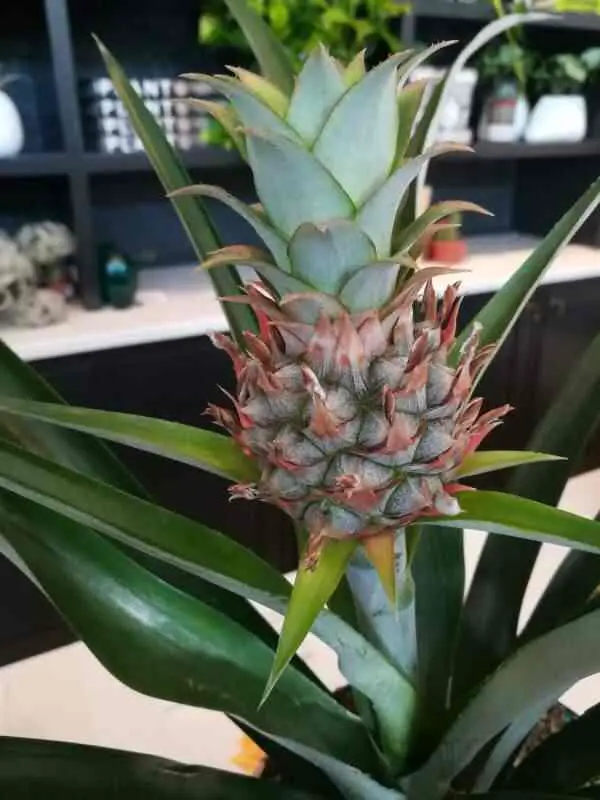
A Pineapple Plant Fruiting
How to Get a Pineapple Plant to Fruit?
In order to get a Pineapple to fruit, you first need a mature, healthy, and strong plant that is at least 18 months old. The next thing on the agenda is to stimulate fruiting. The fruit ripening agent is ethylene and it is produced by apples and many other fruits.
So, what does this fruiting stimulation process look like?
- Place several apples around the Pineapple plant
- Seal the area around the Pineapple so ethylene won’t escape. Use transparent plastic to ensure that the plant will get as much light as possible.
- Move the plant away from direct sun, so it doesn’t cook under plastic. I suggest using a strong grow light during that period
- The apples should be under plastic for a week or two.

Helping my Pineapple Plant to fruit
Check the video below to see how I stimulated fruiting on my pineapple plant with the help of apples
If you’re having doubts or more questions regarding Pineapple plant care, please let me know in the comments below this article. You can also schedule a virtual one-on-one consultation with me and get the help you need.
Harvesting
To harvest pineapples, cut the fruits from the plant with a sharp knife. Remove the stem and leaves and enjoy the Pineapple. If you prefer to store it, do it at room temperature for a few days or in the fridge for up to two weeks.
Varieties of Pineapple to Grow
There are many different varieties of Pineapple to grow. The most common is the Smooth Cayenne. Other popular varieties include the Red Spanish, Queen, and Sugarloaf.
Propagation
There are a couple of ways you can do a pineapple plant propagation, you can propagate it from various plant parts: crowns (or tops), suckers (or pups), and slips (grow at the base of the fruit on the fruit stalk). For home purposes, you will mostly use crowns.
In the video below, check the tips how to properly do the propagation:
And this is how my Pineapple Plant looks after a year and a half after the propagation:
Pineapple soil propagation generally has higher chances of success than water propagation.
Before you can propagate, you need to have a good plant, with healthy-looking green leaves. Here are the propagation steps:
- After twisting off the top, chop off the bottom part of the crown that’s full of sugars.
- Start peeling off the lower leaves.
- Dip the crown in fungicide, leave overnight to callus then pot the next day. ⠀
- Provide as much light as you can (put it in front of the brightest window you have). Being a full-sun plant, your Pineapple Plant will thrive in as much direct sun as possible. Still, make sure to gradually expose your plant to direct sun, since any plant can burn in direct sun if exposed suddenly.
Since an image is worth a thousand words, you can also see soil propagation in the video below
There is another propagating method that isn’t that common and that is propagating Pineapple from the seeds. Yes, Pineapples have seeds, but we usually don’t notice them. Check it out in this video:
FAQs about Pineapple Plant
How to Plant a Pineapple Top?
To plant a pineapple top, cut off the top of a fresh pineapple.
- Remove an inch of bottom leaves, and make sure to remove all of the pineapple fruit from the bottom section
- Dip the crown in fungicide, leave overnight to callus then pot the next day.
- Pot the Pineapple top in soil
- Water the soil, and place the pot in a sunny location. Provide as much light as you can (in front of the brightest window you have) and as much direct sun as you can. Make sure to gradually acclimate your plant to direct sun to prevent sunburn.
- The pineapple top will sprout roots in a few weeks, and you have a new pineapple plant
How Long Does It Take For A Pineapple To Grow?
A Pineapple takes about 18 to 24 months to grow to full size and produce fruit in optimal conditions. In home conditions that will generally be less than optimal it can take several years. It is a tropical fruit and does best in warm, humid climates with plenty of sunshine and well-draining soil.
Do Pineapple Plants Help With Snoring?
No, Pineapple plants don’t help with snoring. Although I would love to bring the good news to all of you who are snoring, I will have to debunk this common myth.
This misconception is based on a NASA study conducted in the 80s. This study explored the influence of plants on air purity and the way plants eliminate toxins in the air and wasn’t related to snoring. Pineapples weren’t even on that list.
Even when it comes to air purification, you would need to have tens, if not hundreds of plants with huge leaves in a very small space to enjoy the benefits of air purification.
Can a Pineapple Plant Fruit Indoors?
Yes, a Pineapple plant can fruit indoors. However, there are certain requirements:
- If the plant is too young, you won’t be able to get it to fruit. It needs to be sufficiently mature (around 12-18 months or more)
- Your plant should have received a sufficient amount of light during those 18 months, a minimum of 40,000 lux (4,000 FC) on average
Commercially produced plants fruit in approximately 18 months due to optimal conditions. Indoors, don’t be surprised or worried if it takes a few years for your pineapple plant to fruit.
Here is how my Pineapple Plant looked 9 months after propagation:
How Long do Pineapple Plants Live?
Pineapple plants can live for up to 20 years in ideal conditions. However, most only live for about 10 years.
What Pot Size is Optimal for a Pineapple Plant?
Optimal pot size depends on the size of your plant and the size of the rootball. Once the roots fill up the pot, repot the plant into a 2-4 inch wider pot (from 6” to 8” or 10” pot).
It is also important to choose a pot that has drainage holes in the bottom so that the plant does not become waterlogged. I would also recommend terracotta pots because they absorb water from the soil, which makes the soil dry out faster and reduces chances of root rot.
Yours Truly,


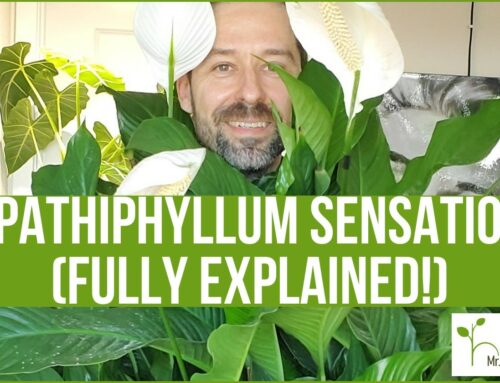



Hi, living in Florida I have been trying to get fruit from pineapples for a few years. I rarely water them. As the plant leaves get yellow too easily. However, we never had any fruit on it yet. Should I go ahead and water them despite the yellowing?
Hi, if your pineapple potted in the ground or in a pot? If in a pot, it might need to be repotted, to get more room. If in the ground, how much light is it getting? Is it in full sun? If not, can you move it to a spot with full sun? That would speed up flowering and fruiting. Don’t increase watering if it leads to the yellowing of leaves. And how rarely do you water, what’s the frequency?
Hi there. I have a few pineapples in pots and they have baby pineapples! I am worried about squirrels and such… Can I now bring them inside the porch in indirect sun to protect the fruit? I’m in Florida. They are outside all day, and I keep seeing squirrels eyeing them up. I wasn’t sure if bringing them in would affect the fruit, or is it best to leave them in full sun.
Hi Kim, it’s so exciting you got a pineapple :) How developed is the fruit? If it’s still small, I would try to find a spot where you can give the plant direct sun. If the fruit is almost fully grown, they indirect light would be fine. You could put a mash wire protection around the plant to protect against squirrels.
I planted my pineapple in a pot but some of the leaves look dry and white/yellow. It’s on the porch and I live in south Texas. How long does it take to start growing?
Hi Tami, it’s normal for some of the leaves to die out. It can take a month or two for new growth to start. It depends on the amount of light, water and temperature. Since you’re in Texas and it’s outside, I’m assuming light and temperature are good. Make sure to water it once the soil has fully dried out. Don’t water before it’s fully dry.
Hello, so glad I found your site. My daughter has been growing her pineapple, cut from a grocery store pineapple, for several years. It keeps leaning and I’m always trying to keep it upright. Its in a very big pot, but I don’t know if I should stake it up or add more soil and pack it to keep it upright.
Hi Margaret, I would suggest staking it and possibly providing it with more light, as that’s what is most commonly missing in pineapple care 🙂
My plant is almost 2 years old. A couple of the leaves were bent back/broken in high winds. Should I cut them off and if so, do I cut at the break ot at the stem? Thanks
Hi Carlie, if the leaves are dry and brown, that means they are fully broken, the brown parts are dead and can be cut off. If the leaves are still green, that means they are still alive and it’s best to not cut them off. But if the plant is large, has a lot of healthy leaves and you don’t like the way the bent leaves look, you can cut them off 🙂
My mini plant has such a large green leaf growth on top of the fruit it is almost as huge as the full plant. Do I take the entire top leaf growth off or pull half off or?
Hi Kathy, can you please send me a photo on Instagram or Facebook? It is hard to say without a photo. Thank you
Hi there! I’m in St. Louis and have been growing a pineapple for the last 3 years, bringing it outside in summer and inside in winter. I finally got a flower a few weeks ago and I understand it may take 5 months before the fruit is fully ripe. So I will have to bring this huge plant indoors again this winter. I would like to really trim back the leaves so it is more manageable… will this be so harmful to my plant? I realize it’s not recommended but it’s either that or not bring it in at all :( and it will then die. Thoughts?
Hi Jill,
I don’t recommend cutting the leaves, as you will be reducing the surface area of the leaves that photosynthesize and produce food for the plant. However, there are a few things you can do to reduce the amount of space the plant will occupy indoors:
1) place the plant in a corner. That will reduce the amount of space it occupies as the leaves on two sides will lean against the wall
2) buy these plastic bags. Slip the plant in and the leaves will stand upwards and won’t occupy much space 😊 I used these bags to pack up all my plants when I moved to a different apartment and they were a life saver. Check out this article on how to move with plants for a photo of my pineapple in a plastic bag. It’s amazing how little space it occupies 😊